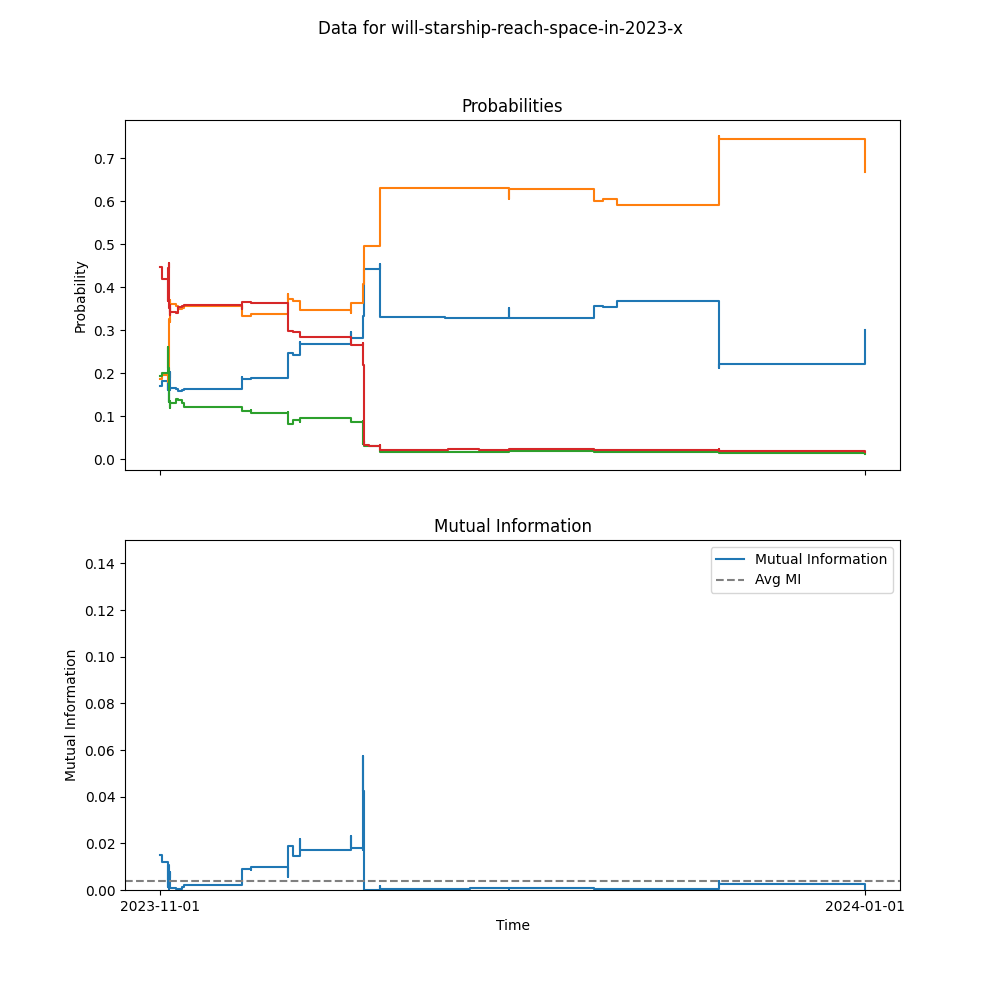The Markets-for-Markets Competition: Final Scores and Retrospective
Hello everyone! Thank you all for following my series of posts on my markets-for-markets competition, hosted on Manifold.
For a quick recap, this was a tournament I organized to foster new market design around the idea of related markets bringing liquidity to each other. Without further ado, here are the rankings:
In fourth place, with an average mutual information of 0.0012 over the tournament, we have metacontrarian, with their market Will Gemini be released before 2024? x Will GPT-5 be released before 2025? Fourth place was unfortunately not enough to win a prize, sorry metacontrarian.
In third place, with an average mutual information of 0.0037 over the tournament, we have James Calder Knight, with his market Will Starship reach space in 2023? x Will a human land on the moon by 2028? James wins a prize of M1000 for third place. Additionally, he wins a super-secret bonus prize of M1337 for pointing out that his submission was actually the only one that conformed to the original eligibility criteria. Nice job on that rules lawyering!
In second place, with an average mutual information of 0.0050 over the tournament, we have Evan, with his market Bitcoin ETF (2023) x New all-time high (2024). Evan wins a prize of M2000.
And in first place, with a whopping 0.0473 average mutual information, we have Jack, with his market Israel-Hezbollah conflict killing >400 before 2024? And US and Iran at war before 2025?. Congratulations to Jack, the M5000 grand prize is yours!
Congratulations to all winners. I will pay out your tournament winnings after posting my resolution code and giving interested parties an opportunity to point out any bugs that might have affected the outcome.
Analysis
Here are the charts that my code produced to visualize the evolution of the probabilities over time and the key figure of merit of the competition: The mutual information of the joint market.
A few observations:
In the LLM and Starship markets, you can identify a discrete point where the underlying for the first marginal market resolved or became certain, and the corresponding possibilities in the joint market collapse to near zero. When this happens, the mutual information essentially disappears, since an event with no entropy can’t have a positive MI with any other event. This left those markets at a disadvantage in the running.
Hilariously, for Gemini, this basically happens twice, since I think there was a little ambiguity in the resolution and the market creator eventually decided the market differently than the traders had it.
The Middle East market you can see something a little similar, when someone came in and moved the market in mid-to-late December. Not obvious to me why all that information would have come at once though. Perhaps an inherent advantage this market had was that no one was very familiar with the subject matter and so it flew under the radar - This market currently has the fewest discrete trades of any of the entrants.
And another observation, not really related to the data here: I felt like I pretty often was able to make fairly large arbitrage trades between the joint markets and their underlyings.
Final thoughts
Overall, I feel like I learned or gained supporting evidence for a couple of theses from the competition.
The first is that the correlations were across the board less than I expected them to be. Part of this could be that there wasn’t enough trading going on, and the prices were just wrong. But another possibility (thanks also to Joshua for a comment about this in the Discord) is that monocausality is just itself very rare, or is at least rare in the context of prediction markets. I think this fact is unfortunate for the vision of joint markets really helping price discovery. But it leads into my second thesis which is:
It would be much better to have bots to arbitrage these markets. This seems like it would have improved the prices, both for the tournament and for the underlyings. Seems like a bit more coding effort is involved there, and I would probably want to make that effort before running a tournament like this again.
A third point is that it seemed like the restrictions on the popularity and timeframes of the markets weren’t that well-done. If I were to do this again, I think that in lieu of hard cutoffs, I would prefer to do something like add a smoothly increasing penalty for markets that were too far in the future. Another factor here was that the matter of the LLM and Starship competitors being hobbled by their early subresolutions felt a bit contrary to the spirit of the competition. I think maybe a better approach would have actually been to shorten the timeframe from two months, maybe down to a few weeks or so.
Thanks again everyone for reading and participating!







